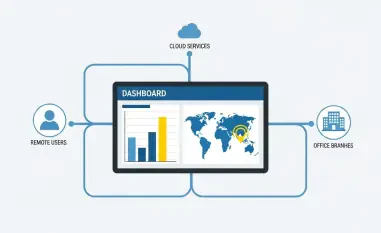In a rapidly evolving digital landscape, the cybersecurity threats that businesses face are growing both in number and complexity. The Cyber Threat Index 2025 report by Coalition offers an extensive analysis of these shifting dynamics, highlighting the most pressing threats and trends set to impact businesses in the coming years. Coalition, known for its innovative Active Insurance solutions aimed at preemptively preventing digital risks, provides a detailed examination of issues such as ransomware, software vulnerabilities, and key attack vectors. This report sheds light on the critical areas where businesses need to bolster their defenses to stay secure in an increasingly hostile cyber environment.
Persistent Ransomware Threats
Ransomware attacks continue to pose a significant risk to enterprises around the globe, as underscored in Coalition’s comprehensive report. The data reveals that in 2024, a substantial proportion of ransomware claims, specifically 58%, stemmed from cybercriminals exploiting perimeter security appliances like virtual private networks (VPNs) and firewalls. This finding indicates a heavy reliance on these security controls, which, if compromised, can lead to devastating consequences for unprepared organizations. Remote desktop products were also a notable target, accounting for 18% of ransomware incidents, further highlighting the ongoing use of established attack methodologies by threat actors.
This persistence in ransomware strategies necessitates a decisive response from businesses, urging them to adopt robust defenses against these conventional tactics. Alok Ojha, Coalition’s Head of Products, Security, emphasizes the importance of proactive cybersecurity measures, noting that cybercriminals often exploit well-known vulnerabilities and techniques. Companies must therefore stay vigilant and continuously update their security protocols to counteract these familiar but effective threats. The need for comprehensive security solutions that can adapt to both current and emerging threats is paramount for safeguarding digital assets in this challenging landscape.
Growing Software Vulnerabilities
In addition to ransomware, the Coalition report projects a significant rise in the number of published software vulnerabilities, with estimates exceeding 45,000 in 2025. This equates to nearly 4,000 new vulnerabilities each month, marking a 15% increase compared to the previous year. Such an alarming surge in discovered vulnerabilities highlights the critical need for diligent patch management and timely software updates to mitigate potential risks effectively. Neglecting this aspect of cybersecurity can leave businesses susceptible to exploits that can be leveraged by malicious actors to gain unauthorized access to sensitive information.
Among the various vectors of attack, stolen credentials (47%) and software exploits (29%) emerge as the most common initial access points for ransomware attacks. Identifying and protecting these key areas is crucial for maintaining a secure digital environment. The report also points out that vendors such as Fortinet, Cisco, SonicWall, Palo Alto Networks, and Microsoft are frequently targeted, underscoring the importance of robust credential management. Regularly updating software, enforcing strong password policies, and implementing two-factor authentication can significantly reduce the risk of unauthorized access via compromised credentials.
Exposure Risks and Security Gaps
Another significant yet frequently overlooked threat highlighted in the Coalition report is the exposure of login credentials. Over 5 million internet-exposed remote management solutions and tens of thousands of exposed login panels were identified, signaling a widespread vulnerability that businesses must address to secure their digital assets effectively. These exposed logins present easy targets for cybercriminals, providing them with a foothold to initiate further attacks or infiltrate more extensive systems.
The prevalence of exposed web login panels among applicants for cyber insurance reveals a critical gap in many organizations’ security postures. This gap necessitates immediate action to elevate awareness and implement strategies designed to secure these exposed entry points. Adopting measures such as frequent audits of exposed systems, utilizing more secure remote management solutions, and ensuring strict access controls can play a significant role in reducing these vulnerabilities. The proactive identification and closure of these security gaps are vital steps in mitigating ransomware risks and enhancing overall cybersecurity resilience.
Proactive Risk Mitigation
Coalition’s approach to proactive risk mitigation, which includes issuing timely alerts for high-risk vulnerabilities, demonstrates an effective strategy for managing cybersecurity threats. Despite only 0.15% of vulnerabilities requiring critical alerts, these timely notifications have enabled policyholders to remediate over 32,000 vulnerabilities in the past year. This sophisticated alert system is integral to helping businesses address potential threats before they can be exploited by malicious actors.
Daniel Woods, Senior Security Researcher at Coalition, underscores the importance of calibrating defensive investments, particularly for under-resourced organizations. A balanced approach that focuses on addressing vulnerabilities, misconfigurations, and threat intelligence is critical for strengthening overall resilience. Businesses are encouraged to diversify their investments across these areas to ensure they remain well-protected against a broad spectrum of cyber threats. By prioritizing the most pressing risks and maintaining a dynamic defense strategy, organizations can better prepare themselves to withstand and recover from potential attacks.
Calibrating Defensive Investments
In today’s rapidly changing digital world, businesses are encountering cybersecurity threats that are increasing not only in quantity but also in complexity. The Cyber Threat Index 2025 report by Coalition provides a comprehensive analysis of these evolving risks, emphasizing the most critical threats and trends expected to affect businesses in the near future. Coalition, renowned for its pioneering Active Insurance solutions designed to proactively mitigate digital risks, delves into issues such as ransomware, software vulnerabilities, and principal attack vectors in this report. The analysis highlights crucial areas where businesses need to strengthen their defenses in order to remain secure within an increasingly aggressive cyber landscape. This forward-looking assessment is essential for organizations aiming to navigate the digital future safely and effectively. As cyber threats continue to evolve, staying informed and prepared is more critical than ever for businesses to protect their operations and data.













